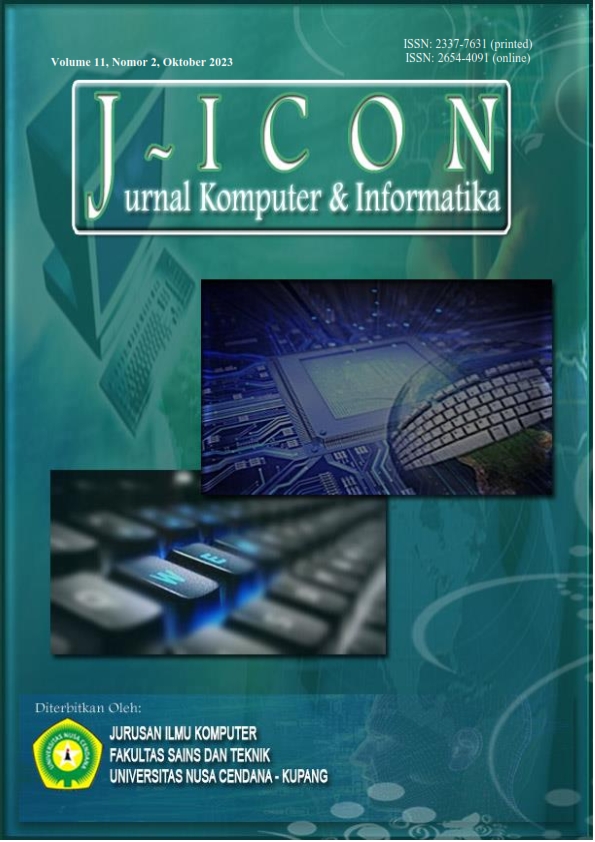WEB-BASED GEOGRAPHICAL INFORMATION SYSTEM OF SCHOOL SPREAD IN TASIKMALAYA CITY
Abstract
Tasikmalaya City is one of the cities in the West Java which has an area of around 184.2 km². According to data from the Ministry of Education and Culture, in Tasikmalaya City there are at least 543 schools consisting of 284 Elementary School, 142 Junior High School, 66 Senior High School and 51 Vocational High School. The purpose of this research was to create a web-based system or application that made it easier for visitors to find the distribution and location of schools in Tasikmalaya City more accurately. The method in this research used the Waterfall in software development because it was very suitable for building web-based geographic information system software. Geographic Information System is a computer system that has the abilities to write, record, store, analyse, and display geographic data. This ability can provide benefits in presenting very accurate location information with the help of the Google Map API owned by Google Map, making it easier for programmers to develop a Map on the Website. Web-based Geographic Information System for the distribution of schools in Tasikmalaya City can give information the location of school accurately and make easier to find it.
Downloads
References
I. K. Sudarsana, “Peningkatan Mutu Pendidikan Luar Sekolah dalam Upaya Pembangunan Sumber Daya Manusia,” J. Penjaminan Mutu, vol. 1, no. 1, pp. 1, Feb. 2016, doi: https://doi.org/10.25078/jpm.v1i1.34.
Republik lndonesia, Undang-Undang Republik Indonesia Nomor 20 Tahun 2003 Tentang Sistem Pendidikan Nasional tentang Sistem Pendidikan Nasional. Jakarta, 2003
Kemendikbudristek, “Data Satuan Pendidikan (DIKMEN) Per Kota Tasikmalaya.” [Online]. Available: https://referensi.data.kemdikbud.go.id/pendidikan/dikmen/026800/2. [Accessed: 13-Apr-2023].
Kemendikbudristek, “Data Satuan Pendidikan (DIKDAS) Per Kota Tasikmalaya.” [Online]. Available: https://referensi.data.kemdikbud.go.id/pendidikan/dikdas/026800/2. [Accessed: 13-Apr-2023].
G. Wiro Sasmito, “Penerapan Metode Waterfall Pada Desain Sistem Informasi Geografis Industri Kabupaten Tegal,” J. Inform. Pengemb. IT, vol. 2, no. 1, pp. 6–12, 2017, doi: http://dx.doi.org/10.30591/jpit.v2i1.435.
Minarni and Y. F. Yusdi, “Sistem Informasi Geografis Pariwisata Kota Padang Menggunakan Application Programming Interface (API) Google Maps Berbasis Web,” J. TEKNOIF, vol. 3, no. 1, pp. 31–37, 2015, doi: https://doi.org/10.21063/jtif.2015.V3.1.31-37.
K. I. Santoso and M. N. Rais, “Implementasi Sistem Informasi Geografis Daerah Pariwisata Kabupaten Temanggung Berbasis Android dengan Global Positioning System (GPS),” Sci. J. Informatics, vol. 2, no. 1, pp. 29–40, 2016, doi: https://doi.org/10.15294/sji.v2i1.4526.
A. Sasongko, “Sistem Informasi Geografis Berbasis Web Untuk Pemetaan Jalan dan Bangunan,” J. Khatulistiwa Inform., vol. 4, no. 1, pp. 1–12, 2016, doi: https://doi.org/10.14421/jiska.2016.11-05.
A. I. H. Mahfudz Ali, Nur Nafi’iyah, “Aplikasi Sistem Informasi Geografis Daerah Rawan Banjir Di Daerah Lamongan,” J-Tiies, vol. 1, no. 1, pp. 283–290, 2017, doi: https://doi.org/10.30736/.v1i1.129.
C. W. Hukama, B. D. Yuwono, and A. L. Nugraha, “Pembuatan Sistem Informasi GNSS CORS UNDIP Berbasis Web,” J. Geod. UNDIP, vol. 7, no. 1, pp. 90–99, Jan. 2018, doi: https://doi.org/10.14710/jgundip.2017.19312.
S. Susanti, E. Junianto, and R. Rachman, “Implementasi Framework Laravel Pada Aplikasi Pengolah Nilai Akademik Berbasis Web,” J. Inform. UBSI, vol. 4, no. 1, pp. 108–117, 2017, doi: https://doi.org/10.31294/ji.v4i1.1562.
Y. M. Geasela, P.- Ranting, and J. F. Andry, “Analisis User Interface terhadap Website Berbasis E-Learning dengan Metode Heuristic Evaluation,” J. Inform., vol. 5, no. 2, pp. 270–277, 2018, doi: https://doi.org/10.31294/ji.v5i2.3741.
R. Firmansyah, “Web Klarifikasi Berita untuk Meminimalisir Penyebaran Berita Hoax,” J. Inform., vol. 4, no. 2, pp. 230–235, 2017.doi: https://doi.org/10.31294/ji.v4i2.2138.
R. S. Pressman, Software Engineering: A Practitioner’s Approach. Britania Raya: McGraw-Hill Education, 2010.
Y. Rahayu, K. Muludi, and A. Hijriani, “Pemetaan Penyebaran dan Prediksi Jumlah Penduduk Menggunakan Model Geometrik di Wilayah Bandar Lampung Berbasis Web-GIS,” J. Inf. Syst. Eng. Bus. Intell., vol. 2, no. 2, pp. 95–101, Oct. 2016, doi: https://doi.org/10.20473/jisebi.2.2.95-101
Copyright (c) 2023 Miftah Farid Adiwisastra

This work is licensed under a Creative Commons Attribution 4.0 International License.
The author submitting the manuscript must understand and agree that if accepted for publication, authors retain copyright and grant the journal right of first publication with the work simultaneously licensed under a Creative Commons Attribution (CC-BY) 4.0 License that allows others to share the work with an acknowledgment of the work’s authorship and initial publication in this journal.
 Miftah Farid Adiwisastra(1*)
Miftah Farid Adiwisastra(1*)




